Searchable abstracts of presentations at key conferences in endocrinology
Symposia
Pitfalls in hormone measurement
ea0035s26.1 | Pitfalls in hormone measurement | ECE2014
Guidelines on GH/IGF1 measurement
For decades, measurements of the circulating concentrations of GH and IGF1 have constituted a mainstay in the diagnosis and clinical management of GH disorders. However, it is also well-known that considerable discrepancies exist between different assays, resulting in highly assay dependent results. Therefore, in 2009 an International Expert Committee was established with the aim to produce an international consensus statement on the standardization and evaluation of GH and IG...
ea0035s26.2 | Pitfalls in hormone measurement | ECE2014
Pitfalls in the measurement and interpretation of thyroid function tests
Accurate diagnosis of thyroid dysfunction is dependent on understanding hypothalamicpituitarythyroid (HPT) axis physiology and the pathophysiology that can affect this classical endocrine feedback loop. Even minor perturbations of thyroid status, which may be imperceptible to the patient and clinician, can significantly alter the relationship between circulating thyroid hormone (TH) levels and pituitary TSH such is the finely-tuned nature of the axis.<p class="...
ea0035s26.3 | Pitfalls in hormone measurement | ECE2014
Advantages in the measurement of steroid hormones
Taylor Angela E , ONeil Donna M , Arlt Wiebke
Mass spectrometry has been used to measure steroids for more than 40 years, but has gained popularity within the endocrine field in the last 15+ years. This is mainly due to technological advances that facilitated the development of high throughput methods.Historically, steroids were measured by crude techniques such as thin layer chromatography (TLC) and later by the more sophisticated RIA. The problems with these techniques include:<p class="abstex...




